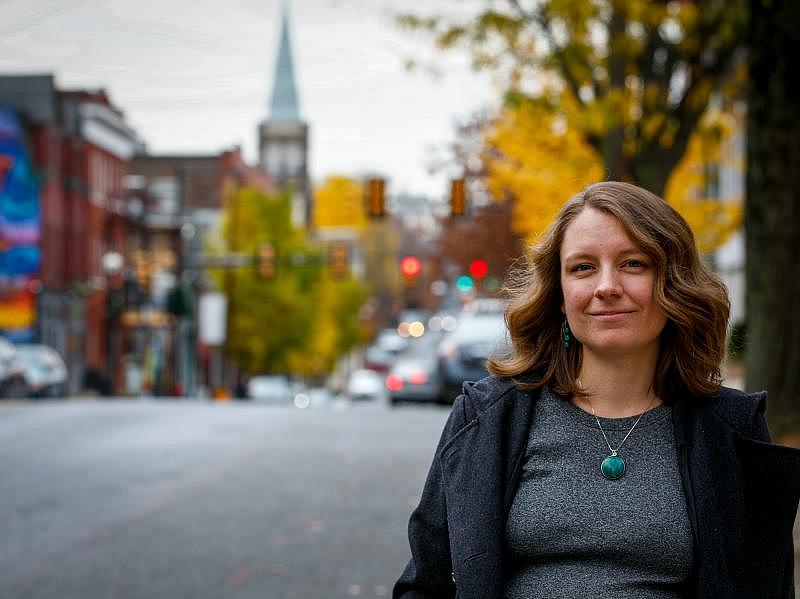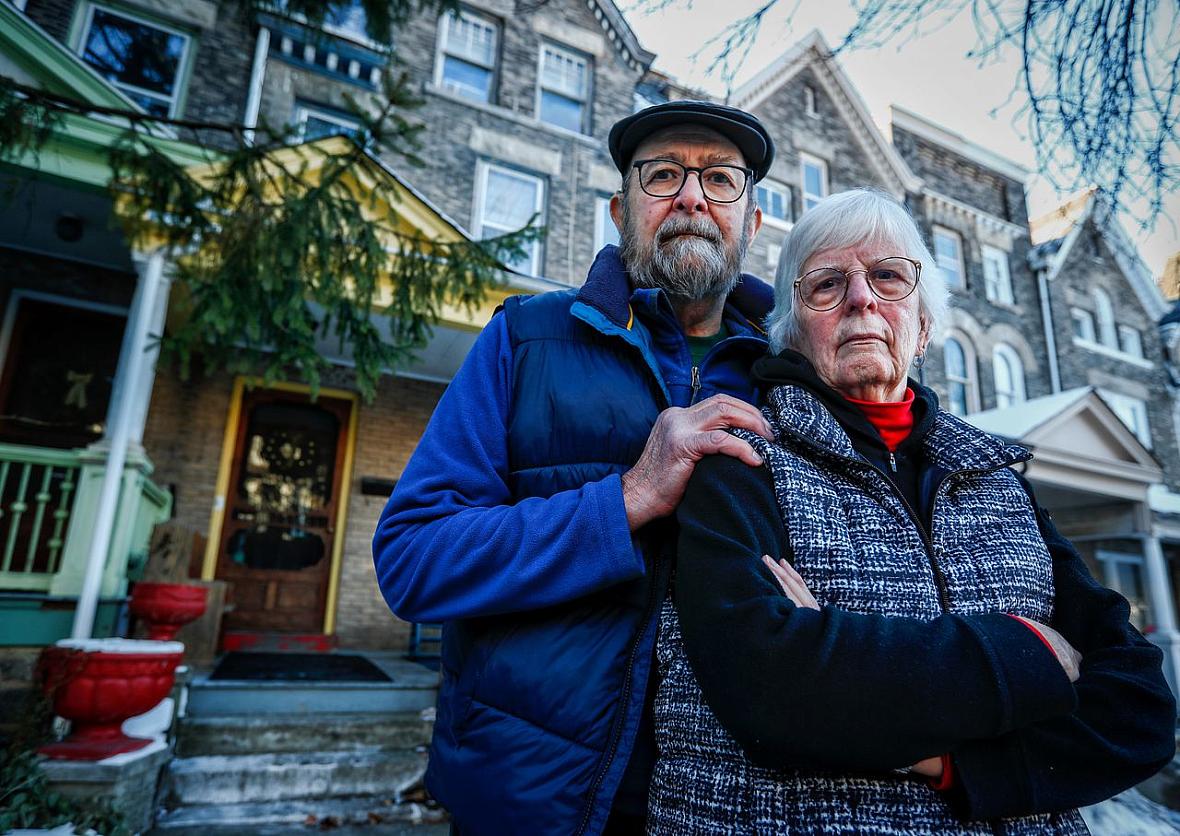The neighborhood to the west of Lehigh University’s campus was primarily families when they first moved to the area in the late 1970s. Now, they are one of five homes on the street that are not student rentals.
They’ve accepted their block will one day all be student housing as it’s now within the city’s designated student housing zone, but they offer other residents in areas on the cusp a blueprint for coexistence.
“We don’t kid ourselves this is salvageable,” Anne Evans said. “All we’ve done for the past two years is fend off developers.”
“We stay here because we are stubborn,” Craig Evans chimed in.
The Evanses introduce themselves right when students move in to remind them adults with jobs and families live on the block, too. They’re not afraid to call the cops when parties get out of hand, but they also lend a hand to students when they need it.
“I can’t tell you how many times we’ve taught people to parallel park,” Craig Evans said.
The couple believes this hard work — and special police details — helped Montclair earn the reputation as a street for students not interested in Lehigh’s party scene.
About six years ago, the Evanses found themselves offering advice to residents on the eastern side of the campus as the traditional bounds of student housing expanded.
Some residents attribute this to Lehigh University taking a harder stance towards on-campus underage drinking and the Greek system. This came at the same time of rising interest in student housing by real estate investors nationwide. Bethlehem’s affordable housing stock made it prime for a deluge of out-of-town investment.

South Bethlehem resident and community organizer Anna Smith helped residents push for a student housing overlay district in the Southside. Saed Hindash | For lehighvalleylive.com
Anna Smith, a Southside resident and community organizer, first noted a shift in the housing market in 2017 as she tracked commercial vacancy rates and residential sales through her former job at Community Action Development Corp. of Bethlehem.
That year there was a 34% increase in the total properties sold in the Southside, many to new LLCs buying in areas not traditionally inhabited by Lehigh students. Home sales prices jumped 18% from 2017 to 2018, after averaging 6% a year previously. She brought the data to the SouthSide Vision housing committee.
In 2016, Lehigh had announced an ambitious growth campaign dubbed the Path to Prominence. The university plans to add 100 faculty and up to 1,800 undergraduate and graduate students in the coming years. While Lehigh intends for most of the students to be housed on campus, the news spurred a rush of new student housing in existing neighborhoods, with additional housing proposed downtown.
This all coincided with a Kansas City-area developer’s plans for a private, dormitory-style housing complex in the area of First Terrace and Hillside Avenue.
They went door-to-door pressuring residents to sell, Seth Moglen, a Lehigh University professor and Hillside Avenue resident, recalls. He characterized their tactics as classic block-busting that included claims others had agreed to sell.
“They didn’t understand we were friends,” he said. “They didn’t understand that the first thing we would do was talk to each other.”
“They really do have a sense of community in that neighborhood,” Anne Evans agreed.
The project fell apart, but it was the impetus for residents to mobilize and lobby the city to help stem the tide of student housing.
Bethlehem officials agreed the rapid expansion of student housing was jeopardizing Southside neighborhoods. City council in early 2021 acted to restrict student housing to certain blocks around the university, ceding what was already lost in hopes of preserving what remains.
Residents are grateful the city intervened with the student housing overlay, but wish it happened sooner.
“It is a bittersweet victory because the victory rests on sacrificing whole neighborhoods,” Moglen said. “We handed them over to student rental companies. They are gone. There is no way to fix them.”
The vote to create the overlay district immediately turned certain Southside homeowners into financial winners, while others took an immediate loss.
Montclair Avenue residents Craig and Anne Evans are holdouts on a block of student housing. Saed Hindash | For lehighvalleylive.com
Sitting inside the zone, the Evanses know they’ll reap the financial benefits whenever they decide to sell. But it is bittersweet to imagine college students slamming the screen door Craig Evans carved by hand or partying on their cheery yellow front porch.
“It’s discouraging to me we are fighting some of the same battles we fought 40 years ago,” Anne Evans said.
They prefer to focus on the the things they love and enjoy their neighborhood. And they try to offer advice and a blueprint for coexistence to other residents on blocks dotted with student rentals.
Their decades of experiences on Montclair echo a pattern that continues to play out on Southside streets: an investor snatches up some homes and the domino falls.
“It kind of cascades,” Craig Evans said, noting their own son is experiencing this in the area of Selfridge Street now.
Montclair Avenue’s conversion to primarily student housing happened quickly in the 1980s once a portfolio of homes on neighboring Birkel Avenue went up for sale. The houses were part of the estate of one of South Bethlehem’s most prolific builders at the turn of the 20th century: Benedict Birkel, a German immigrant.
His will stipulated that his tenants — many who’d been there for decades — get first shot at buying the homes, the Evanses recalled. But most got beaten out by real estate investors.
Local contractor Donald Ronca and three partners snatched up 69 Birkel properties — on the namesake street, Montclair, Minsi Trail and Arcadia streets — for $1.2 million in 1985, according to archives of The Morning Call. Ronca renovated them and got them up to code and sold them off. (He did rent some to low-income families via a partnership with the Bethlehem Housing Authority and sold five homes to a local non-profit group.)
“In a very short period of time the houses turned over to students,” Anne Evans said. “It just accelerated it so fast.”
They still refer to houses on their block by the names of the old owners, a reminder of all the community members they’ve lost over the years. But still the Southside’s overall sense of community keeps them moored to Montclair, despite the challenges of living amongst a growing number of co-eds.
Like so many residents, the family relished living in a place where they could walk to the grocery store, the library, school and their children’s activities.
But plenty of people didn’t understand why they wanted to call South Bethlehem home, a place with a gritty reputation outside the neighborhood.
“You are professionals. Why do you still live there?” Anne Evans recalls others asking. “And they get mad when I get insulted.”
She’s got plenty of stories to illustrate what’s anchored them to South Bethlehem for 42 years.
It’s people like Tony Silvoy, the owner of Goosey Gander, who does so much quietly for Southside. It’s the pizza place that wouldn’t let her pay for her order after her son’s home burned down, claiming the lives of two of his friends.
It’s the fight that earned Anne Evans the nickname “McDonald’s lady.” People stopped her on the street and handed her cash after the Evanses hired a lawyer to stop plans to cut off Montclair’s access to Broadway for the construction of a McDonald’s. (They eventually won.)
“We didn’t know them,” she said of the Southsiders donating money as she walked to the post office. “They just trusted us we would use it to pay our lawyers.”
Our journalism needs your support. Please subscribe today to lehighvalleylive.com.
Sara K. Satullo reported this story while participating in the USC Annenberg Center for Health Journalism’s 2021 National Fellowship, which provided training, mentoring, and funding to support this project. She may be reached at ssatullo@lehighvalleylive.com.
[This article was originally published by Lehigh Valley Live.]


